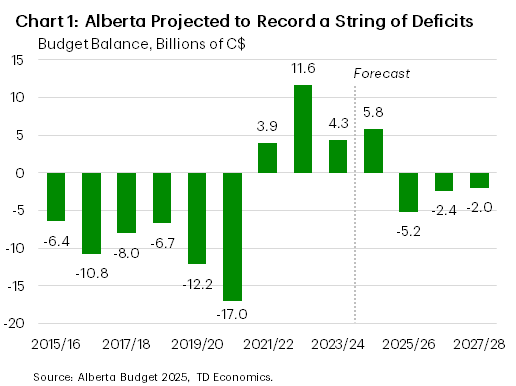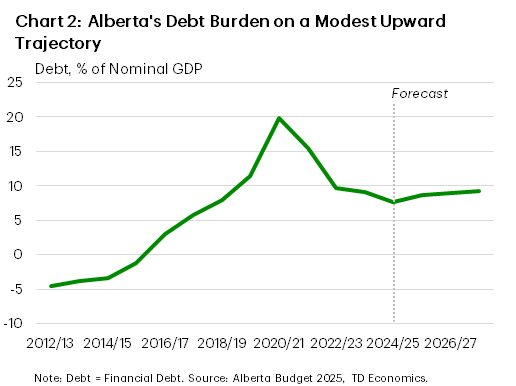2025 Alberta Budget
Bracing for Headwinds
Marc Ercolao, Economist | 416-983-0686
Date Published: February 28, 2025
- Category:
- Canada
- Government Finance & Policy
Highlights
- Alberta’s budget balance is set to swing into red ink after four consecutive years of surpluses. The expected $5.2 billion deficit for FY 2025/26 is part of a cumulative $9.6 billion shortfall projected over the next three years.
- The Alberta government will follow through on its previously promised tax-cut commitment. The introduction of a lower 8% personal tax rate on incomes under $60,000 comes with a $1.2 billion price tag.
- Persistent deficits and increased capital spending will put net debt-to-GDP on a modest upward trajectory. Still, Alberta’s debt burden is not expected to breach 10% and should remain the lowest across provinces.

For the first time since the pandemic, Alberta is projecting a budget deficit, largely reflecting growth forecast markdowns and other prudence adopted in the face of tariff-based uncertainty. The $5.2 billion shortfall targeted for FY 2025/26 – or 1% of GDP – would mark a dramatic $11 billion swing from the surplus now expected for the current fiscal year. In turn, this year’s $5.8 billion of black ink is a significant improvement compared to the razor thin surplus tabled in the Budget plan a year ago. There is no path to balance over the three-year forecast horizon, though the deficit is expected to narrow to $2 billion by FY 2027/28. The Budget also doubles the size of its contingency fund to $4 billion to address unanticipated spending and new economic uncertainty.
Budget 2025 delivers on its promise of tax relief for households. Under the new permanent 8% income tax bracket, those earning $60,000 or more will save $750 on average per year, and Albertans earning less than $60,000 will enjoy around a 20 per cent reduction in provincial income taxes. On the opposite side of the ledger, spending growth this fiscal year is expected to be robust before being pared back in the following two years.
Economic Growth Downgraded, Risks Adequately Considered
Facing heightened tariff uncertainty, the Province has marked down its growth and oil price projections underlying budget estimates. The base-case forecast of 1.8% real GDP growth in 2025 and 1.7% in 2026 represents a downward adjustment of roughly 1.0 percentage point per year from the government’s last forecast in November 2024. Our current forecasts, which are subject to revision given recent developments, are slightly higher at 2.0% growth both this year and next. As we begin to see provinces incorporate fresh risks into their upcoming budget forecasts, we’d still expect to see Alberta fare better economically than most other provinces.
In its budget, the government has assumed a 10% tariff rate on energy exports and a 15% tariff on all other exports for a 1-year duration as well as broad Canadian retaliation on U.S. imports. This is a prudent move and offers some upside to growth projections should Alberta, and Canada, manage to skirt tariffs. Under the province’s downside scenario that assumes a broader trade war with more severe global growth impacts, the provincial economy is forecast to narrowly avoid a recession.
In light of the economic uncertainty, total revenue is projected to dip by a sizeable 8.1% y/y in FY 2025/26, the biggest single-year contraction in 30 years. While tax revenues have been adjusted downward due to weaker growth, non-renewable royalty revenues, which account for almost a quarter of the total intake, exert the largest drag on coffers. A $4.4 million markdown to royalties for FY 2025/26 is driven by lower oil prices, wider WTI-WCS differentials and lingering demand concerns.
The government projects WTI prices to average $68/bbl this fiscal year, a $6/bbl reduction from last year’s estimate, before climbing to $71/bbl next year. These projections align with our view and reasonably incorporate known risks. The Western Canada Select (WCS) price discount to WTI is expected to widen by almost $4/bbl to $17.10. The revenue sensitivity to oil prices is more pronounced compared to last year. For every $1 move in WTI (and $1 improvement in the differential) the combined revenue impact totals ~$1.5 billion, more than $250 million more than the sensitivities included in the prior Budget.
Another factor that will weigh on near-term revenues is the province’s plan to cut personal income taxes at annual cost of $1.2 billion. Moreover, U.S. tariffs are expected to dent corporate income taxes to the tune of $600 million. With tariffs phased out after one year, a projected rebound in the economy is expected to fuel a moderate recovery in revenue growth to around 4% annually over the next few years. Still, that pace would remain slightly below the long-run average.
Alberta Economic Assumptions
[ Percent Change Unless Otherwise Noted ]
| Budget 2025 | ||||||
| Calendar Year | 2023 | 2024E | 2025F | 2026F | 2027F | 2028F |
| Nominal GDP Growth | -4.3 | 5.3 | 1.2 | 3.0 | 3.5 | 4.3 |
| Real GDP Growth | 2.3 | 3.0 | 1.8 | 1.7 | 2.1 | 2.2 |
| CPI Inflation | 3.3 | 2.9 | 2.6 | 2.4 | 2.2 | 2.2 |
| Employment Growth | 3.7 | 3.1 | 1.9 | 1.6 | 1.9 | 2.0 |
| Population Growth | 3.9 | 4.4 | 2.5 | 1.4 | 1.4 | 1.6 |
| Fiscal Year | 23-24 | 24-25E | 25-26F | 26-27F | 27-28F | - |
| WTI Oil (US$/Barrel) | 77.8 | 74.0 | 68.0 | 71.0 | 71.5 | - |
| WTI-WCS Differential (US$/Barrel) | 17.3 | 13.2 | 17.1 | 16.5 | 15.6 | - |
| Natural Gas (C$/GJ) | 2.1 | 1.2 | 2.5 | 3.1 | 2.9 | - |
| Canadian Dollar (US Cents) | 74.2 | 71.7 | 69.6 | 71.9 | 73.8 | - |
Brisk Spending Gains in FY 25-26, More Modest Increases Beyond

Total expenses are slated to rise 5.9% in FY 2025/26, a touch slower than the prior fiscal year, but still robust by historical standards. Spending is focused on improving health care and education with some funding directed toward building a skilled workforce, attracting investment, and increasing trade. Beyond this year, both total and program spending are curtailed, averaging around 1.5% over the projection horizon.
Meanwhile, the province’s capital spending program will expand to $8.6 billion from the $7.6 billion in the prior fiscal year. Key capital investments are focused on education, affordable housing, and transportation infrastructure. Over the three-year forecast, the government added $1 billion to capital plans relative to last year’s budget, bringing it to $26 billion.
Pre-borrowed debt from the past fiscal year is being used to fund this year’s debt maturities, resulting in a 7% reduction in debt servicing costs for FY 2025/26. However, the souring revenue projections for this year prevents any improvement in interest charges as a share of revenues. This “interest bite” is pegged at 4.0% in FY 2025/26, unchanged from the year prior, and is expected to rise another half-percentage point by FY 2027/28.
Net Debt Burden to Rise
The net debt-to-GDP ratio is forecast to rise to 8.7% in FY 2025-26, due to the expected deficit and ramp up in capital spending. Even at this growth trajectory, the debt burden in Alberta remains the lowest of the provinces. Continued projected deficits over the coming years is expected to keep net debt trending mildly higher, hitting 9.3% by FY 2027/28.
Total borrowing requirements in FY 2025/26 are pegged at $11.4 billion, virtually unchanged from last year’s levels. $1 billion of surplus cash was used to offset new borrowing requirements in FY 2025-26. Most of this borrowing is set to be completed with long-term debt issuance. Further, borrowing stays flat the following fiscal year before ramping up to $20/billion the year after.
Bottom Line
The swing into red ink may raise a few eyebrows, but Alberta’s fiscal position remains the most favourable among the provinces. In light of its fiscal framework and careful consideration for key economic risks, the government should comfortably retain this advantage moving forward. Despite their negative impact on the deficit, the brisk spending and the newly implemented income tax cut would provide offsetting stimulus if U.S. trade policy actions (or other downside risks) materialize.
One key risk is that Alberta’s bottom line is still excessively exposed to energy price movements, though we believe the reasonably cautious price assumptions should stand the budget in good stead.
Alberta Government Fiscal Position
[ Millions of C$ Unless Otherwise Noted ]
| Budget 2025 | ||||
| Fiscal Year | 2024-25 Forecast | 2025-26 Estimate | 2026-27 Target | 2027-28 Target |
| Revenue | 80,692 | 74,138 | 77,390 | 79,969 |
| % Change | 8.0 | (8.1) | 4.4 | 3.3 |
| Resource Revenue | 21,509 | 17,067 | 17,620 | 17,816 |
| % Change | 11.5 | (20.7) | 3.2 | 1.1 |
| All Other Revenue | 59,183 | 57,071 | 59,770 | 62,153 |
| % Change | 6.7 | (3.6) | 4.7 | 4.0 |
| Expense | 74,932 | 79,349 | 79,818 | 82,016 |
| % Change | 6.4 | 5.9 | 0.6 | 2.8 |
| Operating Expense | 62,098 | 64,311 | 64,831 | 66,464 |
| % Change | 6.8 | 3.6 | 0.8 | 2.5 |
| Contingency / Disaster Assistance | 2,017 | 4,000 | 3,300 | 3,700 |
| Surplus (+) / Deficit (-) | 5,760 | (5,211) | (2,428) | (2,047) |
| % of Nominal GDP | 1.2 | (1.1) | (0.5) | (0.4) |
| Net Financial Debt | 36,574 | 43,048 | 46,455 | 49,917 |
| % of Nominal GDP | 7.6 | 8.7 | 9.0 | 9.3 |
Disclaimer
This report is provided by TD Economics. It is for informational and educational purposes only as of the date of writing, and may not be appropriate for other purposes. The views and opinions expressed may change at any time based on market or other conditions and may not come to pass. This material is not intended to be relied upon as investment advice or recommendations, does not constitute a solicitation to buy or sell securities and should not be considered specific legal, investment or tax advice. The report does not provide material information about the business and affairs of TD Bank Group and the members of TD Economics are not spokespersons for TD Bank Group with respect to its business and affairs. The information contained in this report has been drawn from sources believed to be reliable, but is not guaranteed to be accurate or complete. This report contains economic analysis and views, including about future economic and financial markets performance. These are based on certain assumptions and other factors, and are subject to inherent risks and uncertainties. The actual outcome may be materially different. The Toronto-Dominion Bank and its affiliates and related entities that comprise the TD Bank Group are not liable for any errors or omissions in the information, analysis or views contained in this report, or for any loss or damage suffered.
Download
Share this: